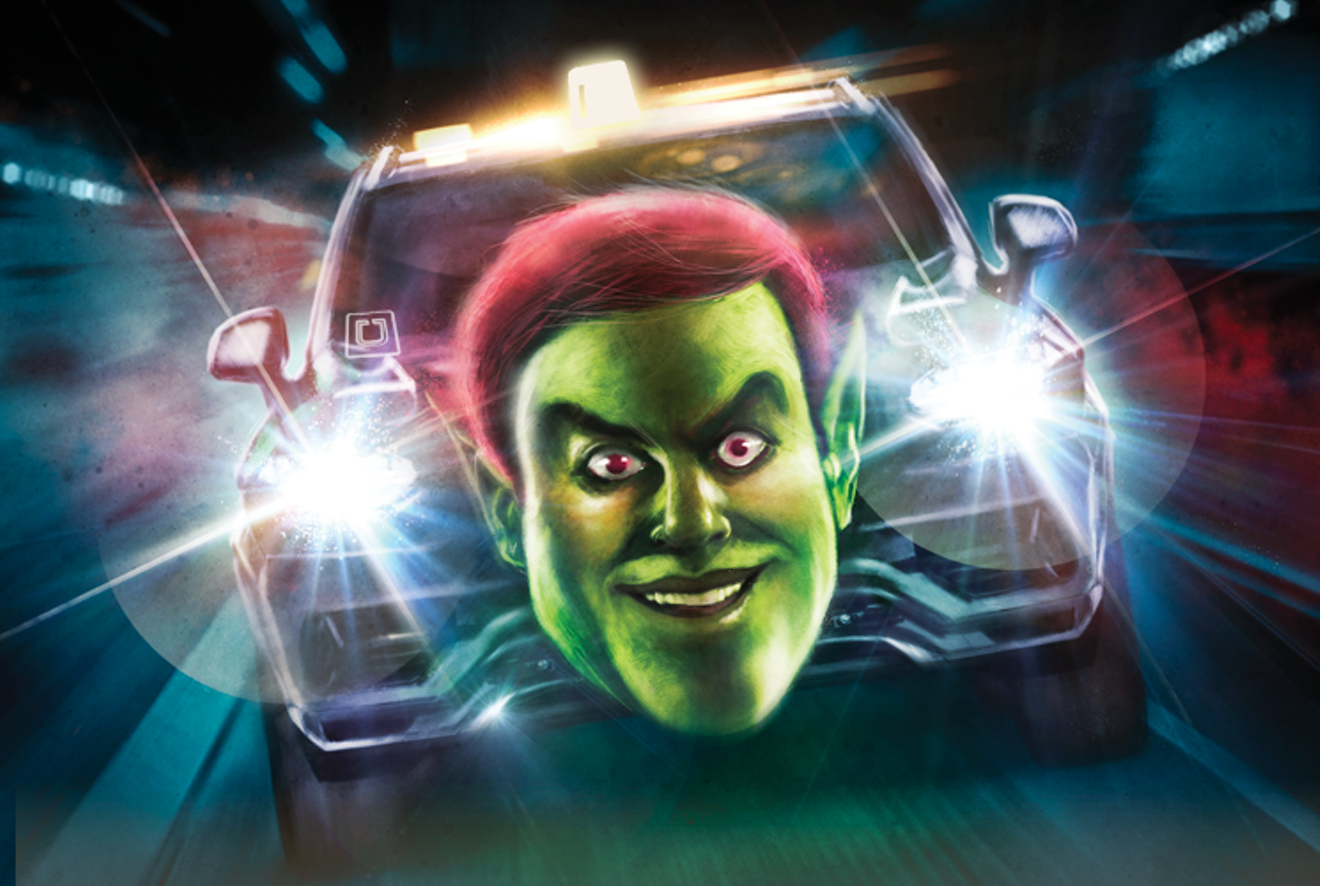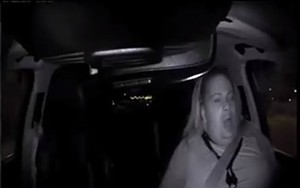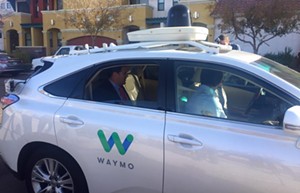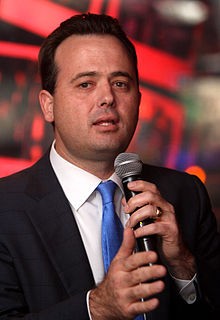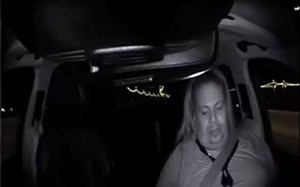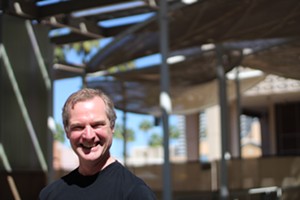Nighttime road conditions were near perfect in Tempe at about 10 o’clock on Sunday, March 18, the night Elaine Marie Herzberg became the first pedestrian in the world killed by a self-driving car.
The air was cool and clear. The sky was moonless, but the crash site on Mill Avenue south of Curry Road lit up from the orange streetlights above.
The small, blond woman walked her pink road bike slowly across the wide, brick-paved median. The bike was old and with no reflectors on its seat stem or wheels. She pushed it along by its handlebars, some sort of bag dangling from her right hand.
Herzberg was a mother and wife, but also a drug addict who was occasionally homeless. The 49-year-old rolled the bike past the signs telling pedestrians to cross at the crosswalk on Curry Road, pushed it off the median’s curb and began to cross the street.
Behind her, the rap artist O.T. Genasis was playing at the Marquee Theatre, but few people were at the show, and its parking lot was mostly empty. On many nights, though, pedestrians can be seen hanging around outside or strolling across one of the two bridges over the Tempe Town Lake."We need to talk about the risks … I really haven’t seen people asking tough questions about what they want this to look like.” — ASU Professor Andrew Maynard
tweet this
Mill Avenue’s famous bar district is just south, on the other side of the lake, but the partying was winding down. Traffic was light.
Herzberg was dressed in a dark top with long sleeves and blue jeans. She walked with a purposeful, but unhurried pace under the orange light. She crossed the first of the two lanes of northbound Mill.
She almost made it to the sidewalk.
She apparently didn’t notice — until it was far too late — the Uber self-driving Volvo SUV and its cameras moving toward her at 38 mph in autonomous mode.
Video released by Uber and Tempe police help recreate the scene of Herzberg’s final seconds alive, and allows the public to know what the driver was doing, too.
Inside the self-driving car was Rafaela Vasquez, who worked for Uber as a backup driver. She was supposed to take manual control of the SUV if anything went wrong. But she wasn’t looking at the road.
Vasquez’s eyes focused downward and to the right as the car sped along at 56 feet per second. Her mouth turned in a sideways grin as she gazed below the dashboard, as if she was reading something amusing. She looked up for a brief moment, gazing left at bridge lights over the Town Lake, then looked back down at her lap.
That’s the moment in the brutal, widely distributed video when we first see Herzberg’s white sneakers appear in an inky black miasma that obscures the view of northbound Mill. The area appears darker in the video than it would have to the human eye.
Then Herzberg’s full body appears, then the pink bicycle. Herzberg’s image pops suddenly into view out of the darkness in the video. She’s smack in the middle of the lane — every driver’s worst nightmare.
A little more than one second elapses from the time she can be seen in the video until the inevitable impact.
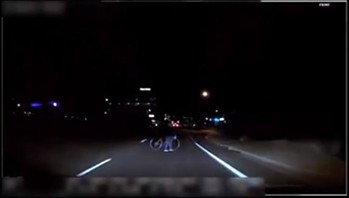
Elaine Herzberg seems to appear out of nowhere in video released by Uber and Tempe police.
Tempe Police
Mercifully, the image freezes in the video before the collision. Tempe police wanted the public to see the video, but didn’t want to release the full file just yet.
Then the video cuts to the interior view of the car, where we can see Vasquez’s distracted gaze followed by the horrified, surprised look on her face at the impact.
As of mid-April, the investigation into what happened was still ongoing. Tempe police are getting help from the Maricopa County Attorney’s Office, National Highway Traffic Safety Administration, and National Transportation Safety Board.
Meanwhile, everyone seems to have an opinion about the crash, and who or what is most responsible.
The pedestrian was not in a crosswalk, but should have been.
The backup driver took her eyes off the road for several seconds before the collision.
And the Uber self-driving car? It looks like total failure.
Police say the car didn’t slow “significantly” before impact. Nothing in the video suggests it slowed or swerved at all before striking Herzberg. Yet the vehicle is equipped with Velodyne lidar, radar, and seven cameras.
Then there’s the question of Arizona Governor Doug Ducey, and his level of culpability.
Ducey has been Arizona’s most visible cheerleader of self-driving cars, and helped bring Uber to Arizona while bragging about the state’s minimal requirements — for safety, or anything else.
“Arizona welcomes Uber self-driving cars with open arms and wide open roads,” he said in December 2016. “While California puts the brakes on innovation and change with more bureaucracy and more regulation, Arizona is paving the way for new technology and new businesses.”
Ducey was sure right about the lack of brakes.
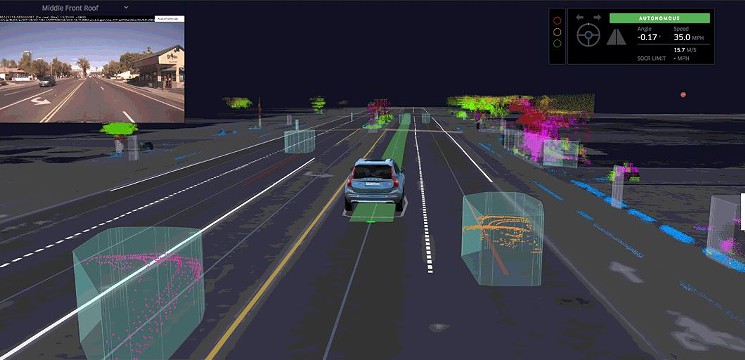
An image from Uber's website shows how the autonomous Volvo XC90 is supposed to see the world with its sensors.
Uber
Worldwide, humans average 100 million miles of driving annually for each vehicle-related fatality, according to Clark Miller, associate professor and scientist at Arizona State University’s Global Institute of Sustainability.
As of March 18, Miller pointed out at a recent panel discussion at ASU, the ratio is now about 10 million miles annually per fatality for self-driving cars.
In other words, from the evidence we have so far, the average for self-driving cars is 10 times worse than for human drivers.
Yet the show will go on: Self-driving technology is a behemoth that isn’t going to be stopped by a single human death.
Companies around the world including Uber, Waymo (Google), GM, Ford, Intel, and many others are spending billions of dollars for a possible chunk of a very lucrative market. Intel released a study last year estimating the self-driving industry might be worth $7 trillion globally by 2050.
Ducey, Arizona’s Republican governor, is a poster child for pro-business government. He would love to help put Arizona at the center of a self-driving revolution. Success could benefit the state economically and give a boost to his political career.
A week after the crash, he ordered Uber to suspend its testing in Arizona, calling the incident “an unquestionable failure” for public safety.
Yet in general he’s kept up his “no brakes” policy. Waymo and the others are allowed to continue operating freely.
The only special rules, besides normal traffic laws, continue to be requirements he put in an executive order on March 1, two weeks before Herzberg’s death. The new rules, which require companies to register with the state, apply only to so-called “fully autonomous” vehicles with no backup driver behind the wheel. As of press time for this article, no company had submitted the paperwork required to operate such a vehicle.
Ducey could make a few more changes, but a crackdown on self-driving car firms could hurt Arizona while simply driving the problem elsewhere. Uber moved to Arizona because it didn’t want to comply with California’s requirements: If Ducey imposed stringent rules on the companies that still want to test here, they likely would put their cars on truck trailers and haul them to another state.
Yet experts say much more could be done to promote transparency and standardized rules that would make the technology safer for everyone.
Ducey has given no indication he’s going to revamp his March 1 order or create a new set of rules.
He seems to think the industry will police itself. But then, the governor has a pattern of over-trusting corporations and business people. In his first few months in office, the former Cold Stone Creamery CEO hired businessmen with little or no government experience to the top posts at the state Department of Economic Security and state Lottery offices, and ended up making big headlines by later firing both.
Elizabeth Holmes and her Theranos scam duped him. Holmes pushed a blood testing system that supposedly needed a few drops, rather than vials, of blood to diagnose medical conditions. Critics called it hokey, but Holmes persuaded the state Legislature and Ducey to pass a law that took away restrictions preventing people from ordering their own blood tests.
Last month, the U.S. Securities and Exchange Commission accused Holmes of $700 million in “fraud.”
The Uber invitation and subsequent tragedy serves as another example of Ducey’s gullibility when it comes to corporate claims. He seems to underestimate their potential to provide failure as well as success.
If Ducey hadn’t invited the company so warmly, or if he’d asked for stricter standards, an Uber car in autonomous mode almost certainly wouldn’t have struck Herzberg. He shares some of the blame because of his decisions.
Uber’s vehicle didn’t do what a human would have done — brake or swerve. The robotic Volvo displayed remarkable Artificial Stupidity.
Of course, it’s possible that Herzberg wouldn’t have survived much longer if she continued failing to use crosswalks at night. Metro Phoenix has one of the highest per-capita death rates for pedestrians in the country.
But her death raises the question: What happens next?
In Arizona, that may depend again on what Ducey does — or doesn’t do.
Self-driving cars are set to move forward to the next phase: no backup drivers. Waymo has reportedly already been doing this since November to a limited extent in Chandler. Other vehicles may soon follow suit.
That’s when testing should get exciting. Especially if companies test their cars on Loop 101 in Scottsdale, in heavy traffic.
Ducey is treating Arizonans like lab rats. Herzberg’s death is collateral damage. The governor has made no moves to force, or even encourage, the car companies to provide the public with the basic information on the test vehicles’ safety or performance records.
To get on the road in Arizona, self-driving vehicles don’t have to prove what every 16-year-old is asked to prove: That they know how to drive.
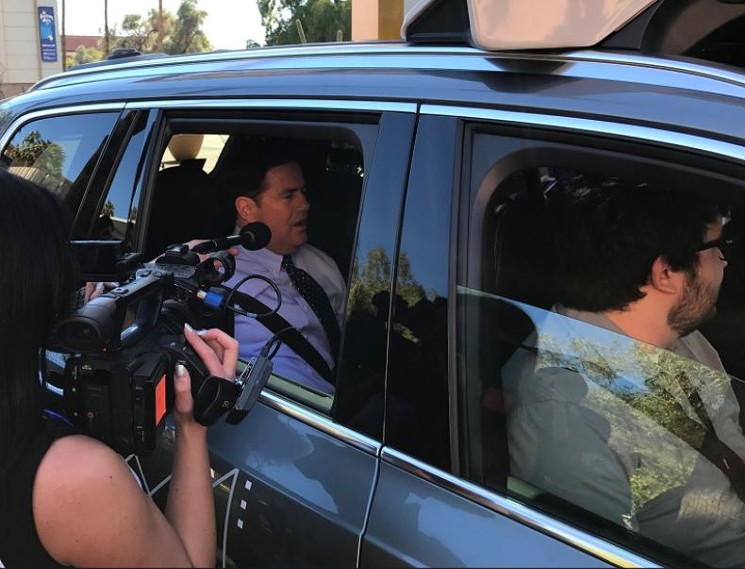
Arizona Governor Doug Ducey took a ride in an Uber autonomous car on February 21, 2017.
@DougDucey via Twitter
The Roger-Benz car had been speeding through the streets of London at 4 mph, its top speed. The driver, a worker for the Anglo-French Motor Co., shouted and rang a bell at Driscoll before his primitive car struck and killed her, according to a 2010 British Broadcasting Corporation article.
The local coroner reportedly said he hoped nothing like that would ever happen again.
In the United States, an estimated 3.6 million people have been killed in motor vehicles crashes since 1899. That’s three times the number of all the Americans killed in all U.S. wars, (1.1 million, according to "PBS Newshour.")
Advocates of self-driving cars claim the technology will slow that horrific carnage, without slowing commerce or the pace of life we’ve come to expect.
It may be that driverless cars and trucks, along with wheeled and flying drones, will be as vital to human beings in the future as automobiles became after Driscoll’s death.
The technology also potentially threatens human beings. Not like wheeled Terminators or the trucks from the Stephen King film, Maximum Overdrive, maybe, but the threat remains, nonetheless.
As Herzberg’s example shows, the cars can be dangerous while engineers are still working out the kinks. But driverless cars are likely to present a number of much larger problems, including some that no one can think of yet.
A possible drawback exists for every conceivable benefit of self-driving technology. One of the most worrisome: It might boost the number of vehicle miles traveled dramatically when humans need to roll back energy use and atmospheric pollution.
Safety, however, is not supposed to be the problem. The most talked-about goal of the technology is to make driving safer.
Waymo’s website states that it’s building “the world’s most experienced driver” to “make it safe and easy for everyone to get around” without a driver.
“Imagine if everyone could get around easily and safely, without tired, drunk or distracted driving,” the site says. “Time spent commuting could be time spent doing what you want, as the car handles all of the driving.”
Yet this Autopia vision of self-driving cars won’t happen anytime soon. Even if (or when) the technology overcomes its biggest challenges, Americans won’t trade in their vehicles by the million over just a few years. The transition will happen over decades. At best, there were will be many years left of crashes caused by tired, drunk and distracted drivers.
Plus, the technology is still in its infancy in many respects.
Autonomous vehicles were just a fantasy until the mid-20th century. With the age of electronics, engineers began to seriously contemplate embedded transmitters that could guide cars along dedicated highways, as seen in a 1956 General Motors film.
The challenge for autonomous vehicles was to make inexpensive but high-quality sensors and cameras, then mate them with portable supercomputers that understand and learn from their experiences. In the early 21st century, many of the challenges have been overcome, and self-driving car companies are hoping to test their latest creations on the road as soon as possible to beat their competitors.
The rapid advance of the industry caught governments at nearly every level by surprise. Ducey’s office said the governor was moved to create his March 1 executive order after the federal government spurred states to create guidelines about the technology in late 2017.
By then, though, Ducey’s plan to turn Arizona into the capital of self-driving technology was well underway.
Until the crash in March, Uber had been testing its so-called self-driving cars relentlessly for more than a year in Tempe’s small, bar-strewn downtown.
Tempe residents grew accustomed to Uber’s experiment.
Mornings and evenings, the streets around ASU and the downtown district teemed with the San Francisco company’s gray Volvo SUVs, each with a spinning, rooftop lidar unit like a boy’s propeller cap.
Four or five of them at a time would gather at the intersections in and around Mill Avenue and University Drive, even on Sunday mornings. Sometimes the vehicles would do unexpected things, like fail to use a blinker or cut aggressively into the usual bumper-to-bumper traffic of the area. It was impossible to tell if they were in autonomous mode at any given time. Perhaps half the time a driver could be seen, the backup driver’s hands were on the steering wheel.
The vehicles were in Tempe because of Ducey.
In December of 2016, the state of California told Uber its cars were not welcome on public roads. Ducey famously told them to come on out to Arizona.
The Department of Transportation followed up Ducey’s comment about not wanting brakes on the industry with a statement touting the lack of rules: “Part of what makes Arizona an ideal place for Uber and other companies to test autonomous vehicle technology is that there are no special permits or licensing required.”
Uber, unlike Waymo and others testing in California, refused to submit to California’s license and permitting protocols. California officials wanted each car to obtain special driver’s licenses. The state also wanted companies operating self-driving cars to submit annual “disengagement” reports, which give details about the times humans drivers needed to take control.
Ducey was already a fan of Uber at the time. A year earlier, he’d used a conflict between the state’s Weights and Measures Department to show how anti-regulation he was.
A few weeks after voters put Ducey in office, Super Bowl XLIX came to metro Phoenix. Shawn Marquez, Weights and Measures director, let it be known that he was going to crack down on Uber and Lyft drivers near the event who weren’t conforming to typical taxi-driver rules. So Ducey fired him, making Marquez the scapegoat in the fight over ridesharing regulation and himself the champion of the new economy, conservative-style.
Pushing Uber and its self-driving car technology was practically a no-brainer for the pro-business governor.
As The Guardian newspaper wrote in an “exclusive” published on March 28, Ducey tweeted a promo for Uber Eats after the company asked him to do so, and held a press conference with Uber on August 25, 2015, about its $25,000 gift to the University of Arizona to help research lidar technology. That day, Ducey put out his first executive order on self-driving cars.
Ashwini Chhabra, the head of policy development at Uber, told the governor’s office in August 2016 that the company was launching self-driving cars on Arizona roads with backup drivers, “starting this weekend,” the article said. Ducey didn’t announce the presence of Uber self-driving cars on the roads to the public until that December.
“Remarkably, the public appears to have been kept in the dark,” wrote The Guardian’s Seattle office reporter, Mark Harris. “Because of Arizona’s regulatory vacuum, neither Uber nor Ducey were obliged to inform the public that Uber’s cars would now be driving themselves on public roads. Neither, it seems, did they believe they had an ethical duty to do so.”
Uber told Harris it didn’t publicly reveal it had begun testing in Arizona because the company was focused on the September 2016 launch of a fleet of self-driving cars in Pittsburgh.
Ducey’s spokesman and strategist, Daniel Scarpinato, took issue with the article, denying that the governor tried to keep anything secret about his willingness to put self-driving cars on the road.
“I think we’ve been very public about it,” Scarpinato told Phoenix New Times, pointing out that the first executive order on autonomous vehicles came out in 2015. “It hasn’t been a secret … If anything, we’ve been criticized for being too braggadocious about it.”
Nothing California requires would have helped Herzberg, had it been done here, Scarpinato said. Ducey did not respond to a request for comment.
With the investigation still pending, it’s too early to tell if Scarpinato is correct.
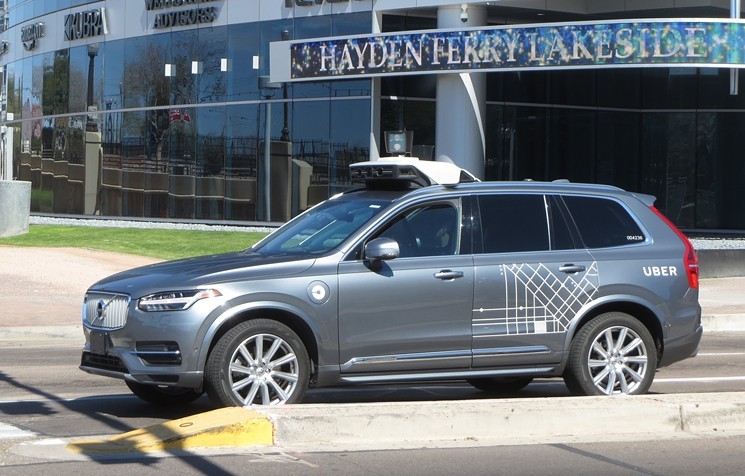
Once in Arizona, Uber focused its autonomous vehicle testing in Tempe, home to Arizona State University.
Zomblelte via Flickr
It was almost too visible and, for those who gave it much thought, sort of mysterious. The public had — and still has — almost no information about the experimental vehicles sharing the roads and whether they’re up to snuff.
In early 2017, when Uber’s testing was getting started in Tempe, a British research firm reported that according to 2016 California documents, Uber’s self-driving cars performed “5,000 times worse” than Waymo’s.
Waymo vehicles, according to documents it submitted to California, could drive 5,128 miles without a human intervention in 2016. The study by Richard Windsor of Edison Investment Research showed Uber cars required an intervention — also known as a disengagement — about every mile.
Uber argues that it counts interventions differently. And indeed, each intervention doesn’t necessarily mean the car performed unsafely or would have wrecked.
Still, experts believe that regulations and government guidance need to be part of the equation as self-driving cars — and their problems — become common.
Three weeks before the crash, Ducey’s office was riding high on self-driving cars.
The March 1 executive order was seen by the public as another sign Arizona was on the leading edge of this technology. The order ended what had been essentially a free-for-all for self-driving car companies, but it requires little more than a basic sign-up sheet for companies that intend to put the more dangerous cars without backup drivers on Arizona roads.
In a rare appearance, Kirk Adams, Ducey’s chief of staff, conducted a conference call in early March with New Times and Scarpinato about self-driving cars.
New Times had asked the governor’s office previously about the safety of the autonomous-vehicle program, and requested documents in 2016 about the governor’s self-driving Oversight Committee. The documents showed that the committee, headed up by John Halikowski, director of the state Department of Transportation, had done basically nothing. Halikowski rebuffed repeated requests for interviews about self-driving cars in the state.
Under the March 1 order, companies have to register with the state if they intend to put driverless cars on the road. If they’ve already begun testing, they have to submit the paperwork within 60 days, the order states. (No companies had complied as of April 10.) The companies’ cars must display federal certification labels and affirm the vehicle will stop on its own safely if the self-driving function fails.
If the companies comply, they’ll be considered “licensed to operate the vehicle” under state transportation law, according to the order.
In the meantime, the Arizona Department of Public Safety has been charged with developing guidelines for local law-enforcement agencies.
DPS is supposed to teach agencies and first-responders how to cope with fully autonomous vehicles in “emergency and traffic enforcement situations, contact information for insurance and citation purposes, and any other information needed to ensure the safe operation of fully autonomous vehicles in Arizona.”
Adams said in the early March interview that the federal guidelines issued last fall were a “seminal” moment, and the Ducey administration believed the time was right to update its 2015 order. Protocols will be standardized “in a way that maximizes public safety and trains police officers on how to deal with the vehicle in any situation.”
It’s a prudent, albeit belated, plan.
Yet, the order begs the question of why there are still no rules are in place for the “Level 2” vehicles that require backup drivers but are made for driving in hands-free mode — like the one that killed Herzberg.
Adams said that Waymo had worked closely with the city of Chandler and the city’s police department “to go through the various protocols.”
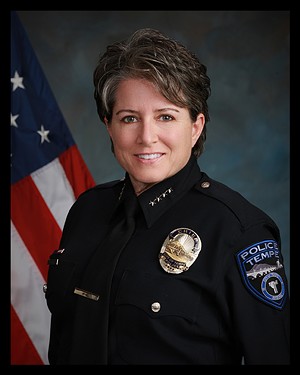
Tempe Police Chief Sylvia Moir refused to talk to New Times about self-driving cars before or after the March 18 crash.
Tempe Police
Chandler Mayor Jay Tibrshraeny invited Waymo to make the city its hub of testing in 2010. After that, the city took a hands-off approach.
The company began in 2016 by testing manually operated cars in the Phoenix suburb. An August 2016 community open house meeting about the program didn’t cause much, if any, concern. Waymo mapped various areas and gathered information for its onboard systems before moving on to the Level 2 phase, which requires attentive backup drivers while in autonomous mode.
“From a city standpoint, our role is not to be a regulator,” Chandler spokesman Matt Burdick said. “Essentially they were advising us on what progress they were making.”
The most significant interaction was a June 2017 test to familiarize Waymo vehicles with the sounds and sights of police and fire vehicles.
Then, in November 2017, Waymo announced it would begin to test vehicles with no backup drivers on the road. Neither Ducey’s office nor Chandler officials moved to force the company to prove its vehicles could meet standards that might prove it was ready to do this safely.
Commander Bryan Cox, who oversees the police traffic bureau, said he wasn’t aware of any meetings between public safety officials and Waymo since the company asked for help with emergency vehicle sirens.
Asked if the governor’s March 1 order was needed, he answered, “Yeah, absolutely.”
The situation was roughly the same in Tempe, where Uber focused its testing.
Tempe Mayor Mark Mitchell first took a call with Uber following Ducey’s December 2016 announcement about Uber, said Tempe spokeswoman Nikki Ripley. On February 21, 2017, Mitchell attended Uber’s autonomous vehicle testing launch event on ASU’s campus.
Neither Mitchell nor Tempe Police Chief Sylvia Moir gave the Uber program much more attention over the ensuing months. The city’s first Uber self-driving car crash on March 24, 2017, resulted in a ticket to another motorist, not Uber or its backup driver.
In January of this year, New Times asked the Tempe Police Department for all of its rules and protocols on self-driving cars. Liliana Duran, the agency’s spokesperson, said, “at this time there is no policy and-or training info on self driving cars.”
Moir declined requests both before and after the March 18 Uber crash for an interview about what she was doing about the vehicles and public safety.
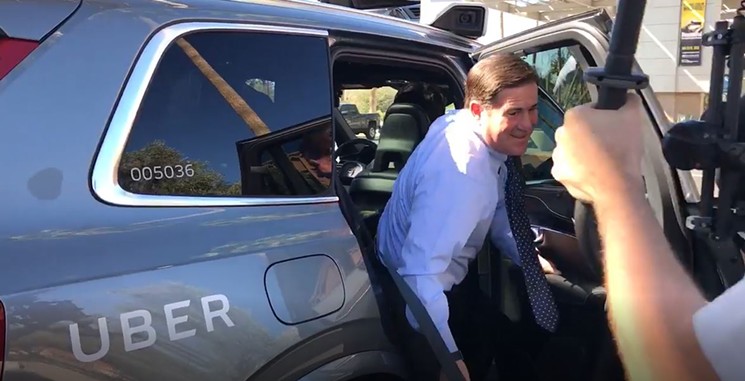
"Thanks for the smooth ride, @Uber_AZ. Arizona is proud to be home to your autonomous vehicle fleet!" — Governor Doug Ducey's tweet after riding in an Uber car on February 21, 2017.
@DougDucey via Twitter
Mill Avenue is lit up brightly most nights until the bars close at 2 a.m. Further north, the bar district ends at Rio Salado Parkway. That’s where Mill Avenue splits into two, one-way roads that go over the Tempe Town Lake on two separate bridges. If the power’s on, it’s never totally dark there.
Decorative streetlights line the sides of the bridges. At the lake’s north end, the streetlights on Mill are the typical, more robust kind, placed every 150 feet.
The Uber crash site is on the right side of the road about 350 feet south of the crosswalk at Curry Road. Almost directly above the site stands a streetlight, and another light pole on the left side of northbound Mill provides more light. It also partially illuminates the wide, flat median with the brick pavers no one’s supposed to walk on.
Sergeant Seth Tyler of the Chandler Police Department believes the pedestrian’s failure to use a crosswalk probably means no one else is to blame.
“I’d be really surprised” if County Attorney Bill Montgomery found fault with anyone other than the pedestrian, Tyler said. “She was jaywalking … You cannot cross mid-block without a crosswalk.”
Herzberg, the woman from Mesa, was walking a bicycle alone — and doing it unsafely — on a Tempe street as much known for its vagrants and vagabonds as partiers and college students.
She went to Apache Junction High School, class of 1985, and has lived in various spots throughout metro Phoenix and the Tucson area for most of her life.
She had a Facebook account with 80 friends. On the site, preserved by Facebook as a memorial, is a brief description of her, apparently written by Herzberg three years ago. It states that she had the first of her children at age 15, that she “stays active in community ~ is currently active in freinds [sic] circle ~ very appreciated by her freinds.”
She’s smiling in a 2015 photo on the site — a happy looking, middle-aged blond white woman in a comfortable home setting, with religious items on small shelves behind her.
She had a husband and at least one child, a daughter, at the time of her death. They apparently took an early payout from Uber. On March 29, a local law firm announced that Uber had “resolved” matters with the family, which many reported as a settlement. Cristina Perez-Hesano, the lawyer, said the family would make no further statements. Other family members have retained a different lawyer.
Whatever her family life, Herzberg may have been homeless on March 18, Tempe police say.
Herzberg, also known as Elaine Wood and Elaine Ziemann, had a history of petty crime, mostly drugs, going back to the 1990s. The last few years have been among her toughest.
She was evicted from an apartment in 2012 for failure to pay rent. In March of 2015, Mesa police responded to a call of a burglary at a church and found Herzberg nearby, claiming she was looking for a stolen bicycle.
The cops found a small amount of weed and meth on her. The bust was a probation violation; she had been convicted of similar charges in 2013 and 2014. But she got a break — until she failed to show for mandatory drug testing. At the time of her arrest her rap sheet included 12 misdemeanors and four felonies, records show.
Her husband, Rolf Erich Ziemann, said in an April 2015 letter to the court that he and his wife of seven years “have both gone through so much bad stuff in the last 4-5 years that it broke our will and spirits!”
Ziemann said his wife suffers from depression and is sometimes homeless. She collects disability “for her mental issues,” he wrote.
He argued that she needed drug and mental-health treatment, and subsidized housing — not prison.
“Elaine is a great woman and mother!” Ziemann wrote, adding that he just got out of prison himself and feels lucky she’s his wife.
The judge sentenced her to more than a year in prison.
Two weeks before she died, she arrived late in court for a hearing on a new meth charge.
Herzberg’s life was a string of terrible decisions. Crossing Mill Avenue mid-block was one of them.
Yet with the lighting available at the site, any attentive driver should have seen her walking first from the median to the first lane, then into the lane nearest the curb.
Any non-distracted, non-impaired driver with average vision likely would have passed Herzberg alive instead of striking her dead.
That’s not even taking Artifical Intelligence into account. Drivers familiar with the area know to watch out for people like Herzberg in the middle of the road. From the video, the Uber car’s brain appears switched off.
Rafael or Rafaela Vasquez also had a prison record: She served 3.5 years behind bars in Arizona for attempted armed robbery.
As with Herzberg, Vasquez’s rap sheet helps shed light on her character and background, but can’t explain what happened the night of March 18.
According to her driver’s license and prison record, she was Rafael Vasquez, a 44-year-old Arizona man. But after 2009, a few years after she was released from prison for attempted armed robbery, she began going by Rafaela.
Her prison time in the mid-2000s isn’t the only evidence that Vasquez can be irresponsible. She’s also a scofflaw who has failed several times in the past few years to keep her own vehicles registered and insured. She got a ticket for running a red light in Phoenix in 2017, though it was dismissed. And in the past two years she’s managed to rack up more than $11,000 in judgments against her in justice court by local landlords.
After the crash, Uber gave New Times the wrong information about Vasquez. New Times asked if Rafael Vasquez — the name Tempe police saw on Vasquez’s driver’s license — was the former prison inmate and Uber driver who hit Herzberg.
Spokeswoman Stephanie Sedlak said New Times didn’t have the right person. The name was Rafaela Vasquez, she said.
When informed that the name Vasquez didn’t bring up so much as a parking ticket, Sedlak wrote back, “Yes!”
Uber has limited its response to the tragedy to condolences for Herzberg. The company won’t say if it knew of Vasquez’s record before she was hired, but suggested that Vasquez met the requirements for commercial drivers in Arizona, which require disclosure of felony convictions within the last seven years.
In the video of the Volvo XC90’s interior, Vasquez plainly can be seen looking down, not at the road. She seems to have been texting. She was cooperative when police interviewed her the night of the crash, but police have not released her statements.
The county attorney’s office will decide whether Vasquez should be charged with a crime.
In the void left by Ducey, police have followed an unwritten rule that anyone behind the wheel of a vehicle can be held responsible for violations incurred by that vehicle. Officials couldn’t tell New Times where that directive came from; Sergeant Tyler said it evolved from the idea of “actual physical control” of a vehicle, a concept used to stop drunk drivers from claiming they were simply sleeping in the driver’s seat, with the engine running, on the side of the road.
Since testing began in Chandler, Waymo cars have been in three minor collisions. In one of them, the backup driver was cited for making an improper turn.
Vasquez, in theory, could be criminally charged in Herzberg’s death even if Uber can prove the vehicle was in autonomous mode.
According to Kirk Adams, Ducey’s chief of staff, Uber and other self-driving car companies could be considered people under the law. They could be criminally charged, if warranted, he said.
In any case, Ducey’s staff said, the governor doesn’t believe that his lax rules on self-driving cars mean the state would be found liable in any civil litigation for collisions or deaths like Herzberg’s.
Adams said that before the crash, though. Whether Herzberg’s family goes after the state for damages remains to be seen — no claims have been filed as of this writing.
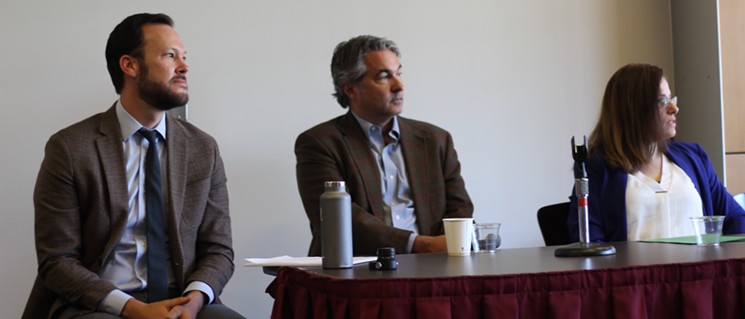
ASU professors Thad Miller, David King, and Lina Karam spoke about the crash at a panel in late March.
Ray Stern
The panel for “Case Critical Series: The Future of Autonomous Vehicles,” included several research scientists and professors — like Clark Miller — who have studied the arrival of the futuristic technology.
“The immediate notion of safety is called into question” because of the crash, Miller said in his opening statements.
Panelist David King, a professor for ASU’s School of Geographical Sciences and Urban Planning, said he was rattled by the car’s failure.
“I’m personally less confident in the technology now than I was two weeks ago,” King said. “I thought what happened on Mill Avenue had been solved.”
King and others previously had good reason for optimism. The sensors on self-driving cars ought to have detected Herzberg long before a human could see her.
Waymo claims its vehicles can detect objects three football fields away, in any direction.
The spinning lidar unit on top of Uber’s Volvos is made by Velodyne, which claims that its product can detect objects up to 600 feet distant. Lidar works by beaming out invisible laser bursts that bounce off objects, then studying the beams as they return. Videos on the websites for both Velodyne and Uber show the Volvos moving through a video-game landscape that detects and puts electronic boxes around all kinds of objects.
Velodyne’s executives told news media they were “baffled” over the crash, adding they don’t believe the lidar system failed. They said the blame for the car’s non-reaction must be put elsewhere.
The crash highlights how little the public knows about the performance of autonomous vehicles, not to mention how little is known about their performance in Arizona, panel members pointed out.
Waymo, which claims its vehicles would have detected and avoided Herzberg, nevertheless refused to divulge to New Times any disengagement data for its operations in Chandler.
We’re supposed to trust that when we see these vehicles zipping around town without anyone in the driver’s seat, like in the viral YouTube prank where the driver dresses like a car seat, nothing could go wrong.
Some experts say trust isn’t enough.
Columbia University Professor Hod Lipson, in his 2016 book, Driverless, with writer Melba Kurman, argues for the careful introduction of regulations or government guidance that might someday be comparable to the Federal Aviation Administration.
“A driverless license is a good start, but a significant amount more research and exploration of regulatory oversight is needed,” Lipson’s book states. “Ideally, the highest levels of government should adopt a proactive, rather than reactive, approach.”
Lipson suggests the creation of a Federal Autonomous Vehicle Agency, “similar to the FAA,” which would have the effect of advancing self-driving technology as well as promoting safety standards: “The AVA would be responsible for setting an aggressive and visionary strategy to make driverless cars a reality across all 50 states.”
Yet Lipson, like other self-driving car experts New Times interviewed, is more than ready to see the experiment continue “as painful as it might be.”
“There are 22,000 fatalities a week around the world,” he said. “It’s like a nuclear bomb going off once a month.”
Andrew Maynard, a professor of risk management at ASU, was mostly optimistic about the safety of self-driving cars when New Times talked to him before the Uber crash. Maynard struck a different tone after attending the March 30 panel discussion with about 100 others.
“My attitude has changed over the last 10 days,” Maynard said. “We need to talk about the risks … I really haven’t seen people asking tough questions about what they want this to look like.”
The panel’s experts discussed the possibility of requiring driver’s licenses for each car, to show they can meet minimum standards. But no one seemed ready to throw out the companies, or Ducey, just yet. The self-driving car experts respect Ducey for his boldness on the issue, and they realize he can’t impose a slew of new and onerous rules without driving the companies out of state.
Still, everyone wants to learn more about the vehicles — and how safe they really are.
Ram Pendyala, a professor at ASU’s School of Sustainable Engineering who also came to hear the talk, said he wants to see the tests continue, but with more transparency. He suggests that Arizona and other states consider asking companies to provide relevant scientific data — not just disengagement reports — about their vehicles, which could be “vetted” by a neutral third party to avoid giving away trade secrets.
“I think that’s a very good conversation to have,” he said.
If Ducey can’t figure out a way to hold the companies accountable, the companies could do it themselves.
The new transparency could start with the recent, local performance reports on Waymo or any other companies intending to put no-backup driver vehicles on Arizona roads.
If we have to be Ducey’s guinea pigs, we should at least know more about the experiment.
(Correction: The $25,000 gift by Uber was to the University of Arizona.)

